If you’ve read any news on the Tennessee Valley Authority (TVA) in the last few months, you may think TVA is well on its way to add 14 gigawatts (GW) of solar to the system. This is not only inaccurate, it is intentionally misleading, and further reiterates our concern that TVA is not serious about renewable energy development in the Tennessee Valley.
First let’s take a step back and provide a little context. One GW is 1,000 megawatts (MW), which is a measure of how much solar the utility has available. One GW of solar provides enough energy to power approximately 150,000 homes. TVA serves approximately 4 million residential customers in their service territory spanning across seven states.
Now that you have that information in your back pocket, let’s compare TVA to its peers. TVA currently has less than half as much solar on its system as compared to similarly sized utilities in the Southeast. TVA is behind now and will remain significantly behind over the course of the next five years.
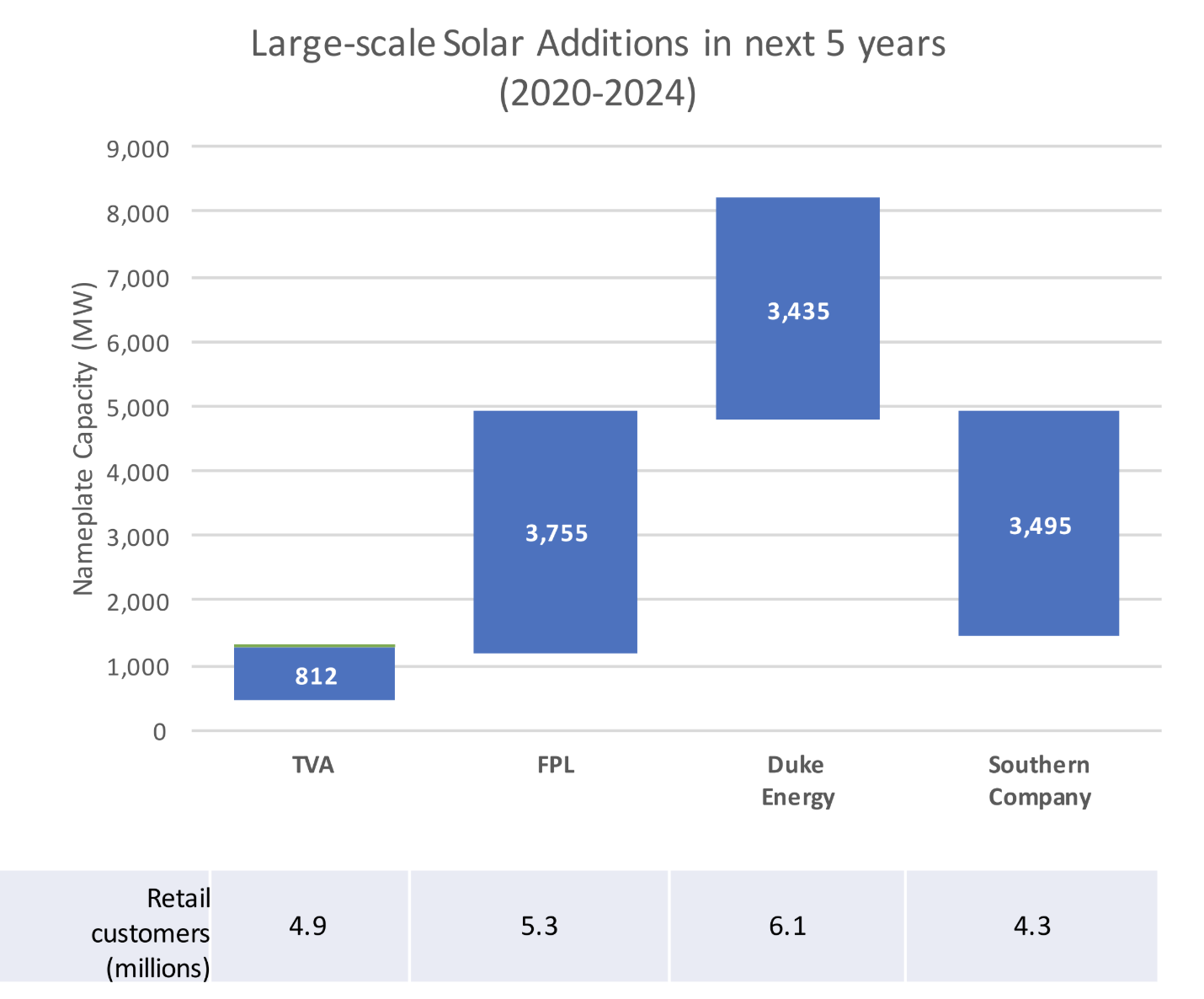
We at Southern Alliance for Clean Energy (SACE) call it like we see it. Unfortunately, what we see is that despite recent headlines, TVA is not on track to add 14 GW of solar. In fact, they’re nowhere near it. We couldn’t stay silent and watch the misinformation fly without setting the record straight. So here it is, the true story of where the 14 GW of solar figure came from, and what TVA is actually doing about solar.
It all started in early 2019…
February 20: TVA releases draft Integrated Resource Plan
TVA finalized its long-term plan for meeting power needs called an Integrated Resource Plan (IRP). To create a plan like this, utility staff analyze many future scenarios for the next 20 years. Below is a snapshot of what this draft contained:
- An arbitrary, hidden limit to add a max of 0.5 GW of solar per year.
- Results hit solar limit in every possible year in 22 of 30 scenarios.*
April 8: Comments due on draft IRP
TVA received 1,200 comments on its draft IRP, relevant highlights:
- The most frequent topics included “increased use of renewable energy, reduced use of fossil-fuel generation, and increased energy efficiency.”
- Many organizations and individuals asked TVA staff to remove the 0.5 GW annual limit on solar (including SACE).
April 17: TVA Staff present additional results to RERC
TVA staff re-did the base case without the solar limit and presented these additional results to the Regional Energy Resource Council (RERC):
- Re-done analysis was not completed on a case that hit the annual limit in all possible years but still included more solar.
- SACE staff suggested to TVA staff that they do another case where they remove the solar limit for a case that hit the limit in every year.
On June 5th, TVA starts to push the idea to the public that it will install more solar than it actually plans to.
June 5: Public Webinar to present additional results
TVA staff held a public webinar on the IRP, which included the additional case suggested by SACE: scenario where demand for electricity grows much higher than expected and without limiting annual solar additions.
- Results for this case showed solar up to “the total potential” of 14 GW.
- TVA’s presenter implies that the 14 GW is an outlier when she said it is from one of the “extreme cases” and not one of “the 30 primary cases.”
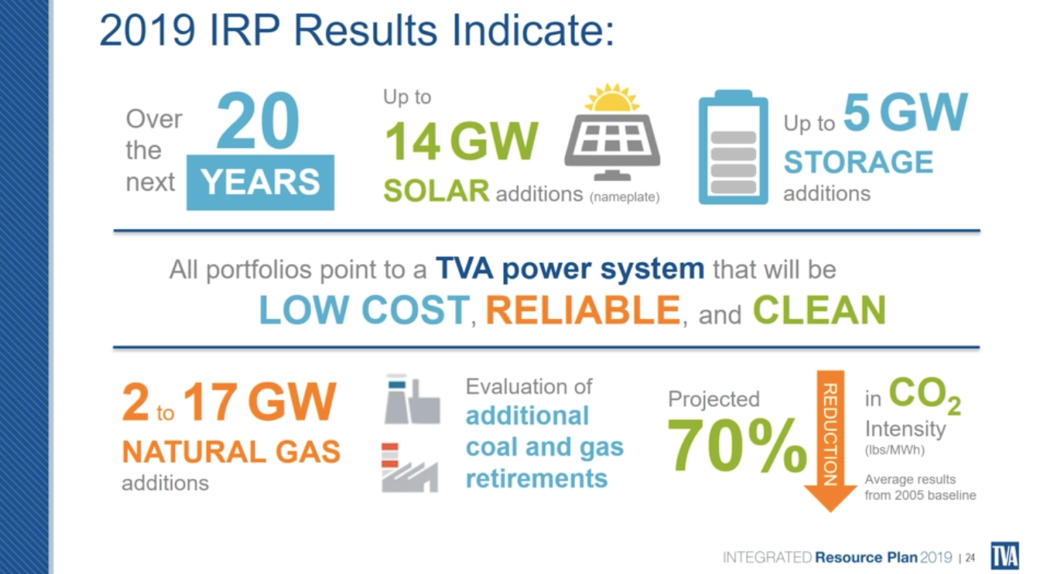
June 28: TVA publishes final IRP
TVA published the final IRP that included the following.
- “Likely” scenario includes 6 GW of solar, from data in the Appendix on page 243 of 290.
- Infographic touts “up to 14 GW of solar” without context on page 2 of the executive summary.
July 1: “14 GW of solar” headlines begin…
From the beginning of July through at least the end of August, media picked up TVA’s claim that it plans to add “up to 14 GW of solar.”
- The 14 GW figure was included in TVA’s 8/22 press release.
- On August 27 TVA tweeted an article about “our plans to add 14GW of solar.”
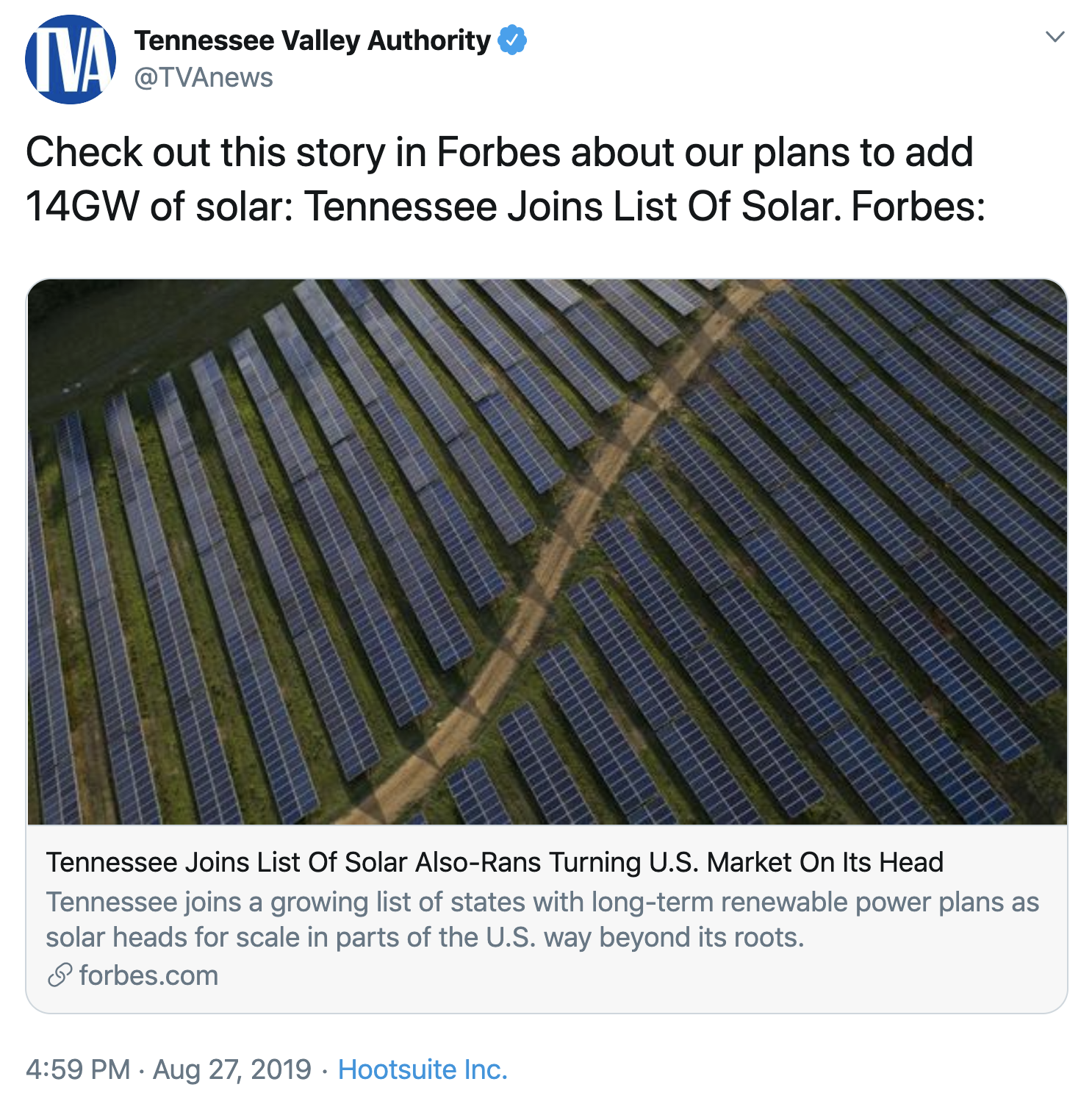
It is unfortunate that the nation’s largest publicly-owned power entity has to resort to misinformation to cover up failed leadership on renewable energy.
August 22: IRP and Budget approved by TVA Board of Directors
The Board approved two major future plans at its quarterly meeting in August.
- Approved IRP: the “up to 14 GW” phrase appeared both on the slide and in CEO Jeff Lyash’s commentary.
- Approved 10-year budget: included funding for up to 5.5 GW by 2030.
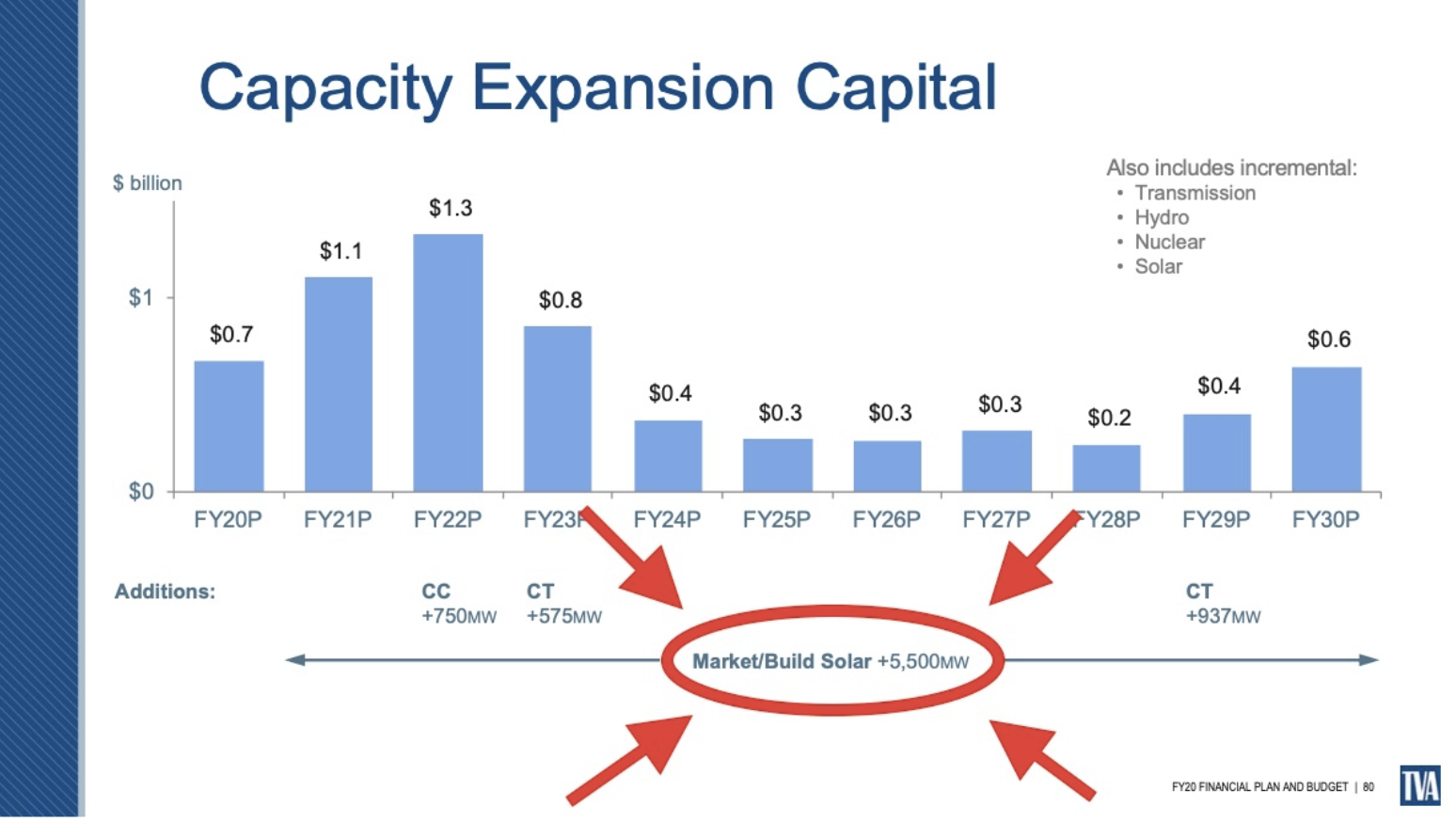
TVA: not just not transparent, also intentionally misleading
So the 14 GW of solar figure comes from an extreme case that TVA’s own staff deems unlikely. However, TVA has latched onto this hyperbolic future in order to mislead the public and present themselves as a solar leader despite their continued attempts to block solar in the Southeast. We think it is extremely unethical of TVA to continue to mislead the public into thinking TVA is actually planning to add significant solar in the near term. TVA either needs to put an end to the misinformation, or put forth an actual plan to aggressively add solar.
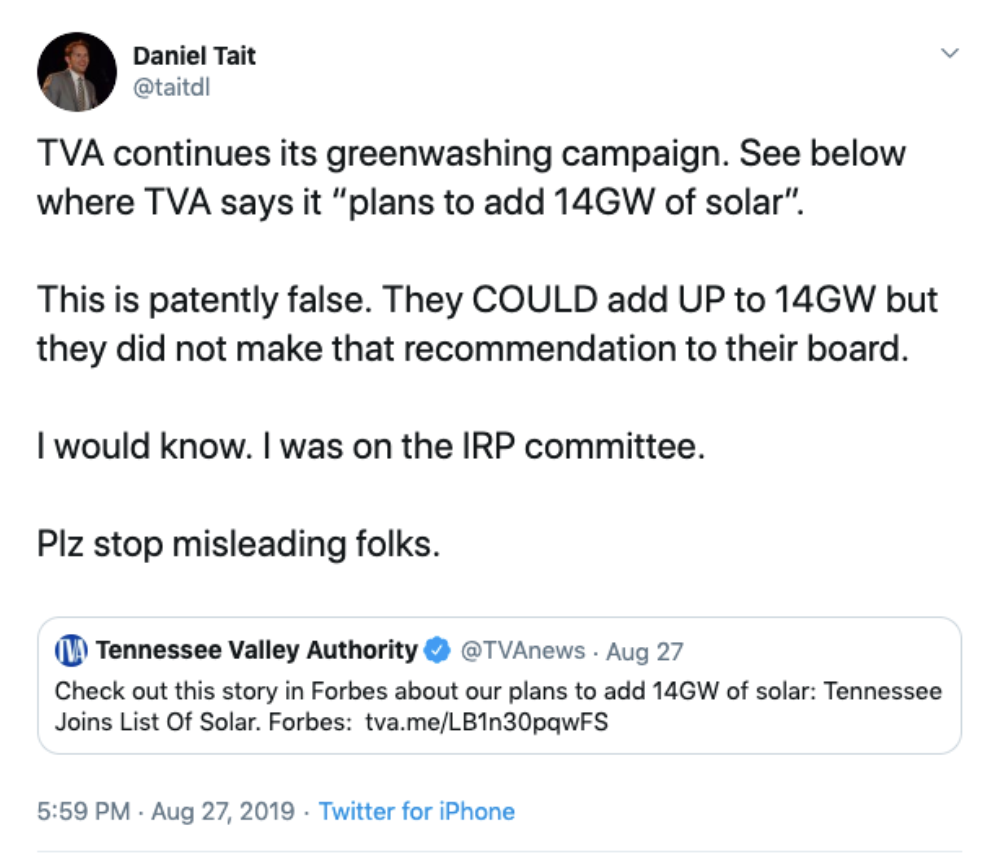
IRPs are most useful in providing direction on near-term utility plans, say the next 5 years. Despite what you’ve heard, even this IRP shows TVA far behind comparable utilities.**
So there you have it, that’s the origin for TVA’s supposed solar leadership. Ideally, TVA would actually pursue solar aggressively right away to add 14 GW in the next 20 years or earlier – instead of labeling the 14 GW case as an outlier. At a time when we need to limit warming the planet to avoid the worst impacts of climate change, large carbon emitters like TVA must reduce greenhouse gas emissions and not mislead the public about what it is doing to address the climate crisis. It is unfortunate that the country’s largest “public” utility continues to mislead the public it claims to serve and ignore customer demand for renewable energy resources like solar. We’d like TVA to either stop misleading the public or demonstrate a clear commitment to how they’ll get to 14 GW in the next 20 years. The benefits of solar are boundless and TVA should stop blocking the sun.
*Explanatory math: solar possible in 17 of 20 years (due to 3-year lead time assumption), therefore 17 years x 0.5 GW/year = 8.5 GW total.
**The TVA Board approved a budget for TVA that only includes the addition of up to 5.5 GW of solar, significantly less than they would need to be on track to get to 14 GW. See slide 80 of the Board presentation.



